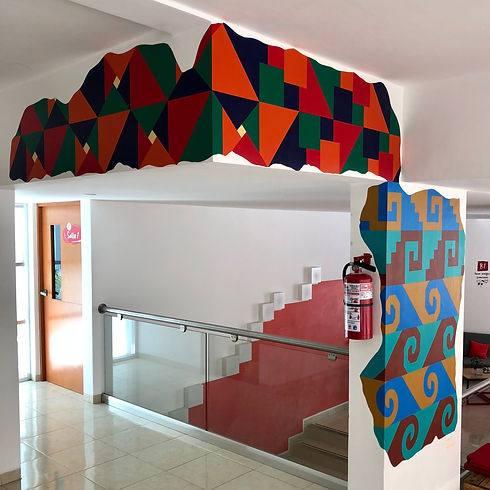top of page
French Alliance
of Merida
Calle 23 por 24 #117
Colonia Mexico
97125 Merida
Yucatan
Mexico



At the opposite of my usual visual universe, I interested myself in pre-Hispanic geometric patterns which represent a form of perfection in their composition. The mural I created for the Franch Alliance of Merida can thus be understood as a tribute to those civilizations where geometry used served as a representation of the world and carried within it a magical power.
My starting point is one of the engravings at the Zapotec archaeological site of Mitla (in the state of Oaxaca, Mexico), whose name comes from "Mictlan", which means "place of the dead" in Nahuatl. As such, the site was seen as a gateway to the underworld. Similar motifs exist on many other pre-Hispanic archaeological sites, but the one of Mitla is particularly achieved.
The pattern reproduces an identical shape on two bands, with a double play of symmetry between the top and the bottom, and between the hollow and the relief. The central motif itself breaks down between a staircase (or pyramidal mass) and a spiral (or hook) whose number of elements is identical and increases and decreases symmetrically (1-2-3-4-5 for the staircase and 5-4-3-2-1 for the spiral).
Different interpretations exist on the meaning and symbolism of this geometric pattern. To mention a few, the engraving can be understood as a stylized representation of the storm, with the spiral for the wind, the zigzag for the lightning, the ascending pyramidal mass for the thunder and the descending pyramidal mass for the rain. At a more complex level, it can be seen as a representation of the duality of cosmic forces, their combination and their struggle. It can also represent the connection to the sky and the earth, with the stairs representing the ascent or descent, and the opening of the spiral giving access to the underworld. This last interpretation fits perfectly with the original destination of the site.
The symbolic scope and the perfection of the motif gave me the desire to produce a work as a counterpoint to my usual work. My works are generally built by a balance between symmetry and asymmetry. The part of dissonance that goes into their compositions reflects the part of chaos that exists in everything, but also the precariousness of the balance and harmony of the whole. On the opposite, Mitla's pattern presents a symmetry and a regularity that recall a vision of the world characterized by its permanence and a perception of time defined by its cyclicity.
However, the point was not to reproduce these geometric patterns as they are, but to propose different evolutions and shapes. The essential elements of symmetry and repetition of patterns, their arrangement in bands, and the concept of ascent and descent are preserved. The evolution relates to the colors and shapes that compose the patterns. For the French Alliance’s mural, a first evolution consisted in breaking down angles and moving towards rounded shapes. For this part of the fresco, I opted for color associations close to those used in certain cases in pre-Hispanic art, namely earthy and turquoise colors. A second development consisted of replacing the double spiral with a symmetrical composition of squares or triangles that join and oppose around a central point. For this second part of the mural, I opted for color associations that I usually use, namely the complementary colors in their intense and saturated expression.
Ultimately, this experience of geometric construction from pre-Hispanic patterns allows a better understanding of the architecture and the symbolic significance of these patterns. This is a practical way to approach the pre-Hispanic culture and its vision of the world. But the evolutions and new compositions proposed from the pattern also aim to reactivate its symbolic significance. The junction with more modern elements of composition and colors tends to bring pre-Hispanic representations closer to our own universe of representation, thus allowing easier understanding and appropriation on the part of the public. Finally, the creation of a fresco in a public place, in the heart of the city and visible in the course of daily life, helps ensure a familiar presence and give it a living image.
bottom of page





